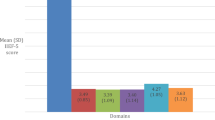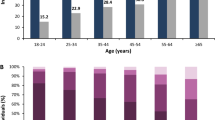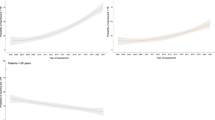Abstract
We interviewed a population sample of 2412 men aged 40–70 y in Brazil, Italy, Japan and Malaysia about medical history, lifestyle habits and sexual behavior. Men were classified as having moderate or complete erectile dysfunction (ED) if they reported to be sometimes or never able to achieve and maintain an erection satisfactory for sexual intercourse, respectively. There were 1335 men with no diagnosis of cardiovascular or prostate diseases, diabetes, ulcer or depression, nor taking hormones. The prevalence of ED was 16.1%. ED was associated with age (the risk increased 8% per y), moderate (odds ratio (OR)=2.2) or severe (OR=4.9) lower urinary tract symptoms and smoking (OR=2.3 for >30 cigarettes/day). It was inversely associated with physical activity (OR=0.5) and higher educational levels. Between the ages of 40 and 70 y, almost one in six ‘healthy’ men is affected by ED. Further research should look at preclinical disease stages and genetic factors.
This is a preview of subscription content, access via your institution
Access options
Subscribe to this journal
Receive 8 print issues and online access
$259.00 per year
only $32.38 per issue
Buy this article
- Purchase on Springer Link
- Instant access to full article PDF
Prices may be subject to local taxes which are calculated during checkout

Similar content being viewed by others
References
Feldman HA et al. Impotence and its medical and psychosocial correlates: results of the Massachusetts Male Aging Study. J Urol 1994; 151: 54–61.
Panser LA et al. Sexual function of men aged 40 to 79 years: the Olmsted County Study of Urinary Symptoms and Health Status Among Men. J Am Geriatr Soc 1995; 43: 1107–1111.
Koskimäki J, Hakama M, Huhtala H, Tammela TLJ . Effect of erectile dysfunction on frequency of intercourse: a population based prevalence study in Finland. J Urol 2000; 164: 367–380.
Blanker MH et al. Erectile and ejaculatory dysfunction in a community-based sample of men 50 to 78 years old: prevalence, concern, and relation to sexual activity. Urology 2001; 57: 763–768.
Sullivan ME, Keoghane SR, Miller MA . Vascular risk factors and erectile dysfunction. BJU Int 2001; 87: 838.
Bacon C et al. Duration of diabetes and risk of erectile dysfunction among older men. Diabetes 2001; 50(Suppl 2): A456.
Burger B, Weidner W, Altwein JE . Prostate and sexuality: an overview. Eur Urol 1999; 35: 177–184.
Mathew RJ, Weiman ML . Sexual dysfunctions in depression. Arch Sex Behav 1982; 11: 323–328.
Wein AJ, Van Arsdalen K . Drug induced male sexual dysfunction. Urol Clin N Am 1988; 15: 23–31.
Nicolosi A et al. The epidemiology of erectile dysfunction in four countries: Cross-National Study of the Prevalence and Correlates of Erectile Dysfunction. Urology 2003; 61: 201–206.
Weissman MM et al. Assessing depressive symptoms in five psychiatric populations: a validation study. Am J Epidemiol 1977; 106: 203–214.
Barry MJ et al. for the Measurement Committee of the American Urological Association. The American Urological Association symptom index for benign prostatic hyperplasia. J Urol 1992; 148: 1549–1557.
NIH Consensus Conference. Impotence. NIH Consensus Development Panel on Impotence. JAMA 1993; 270: 83–90.
Schlesselman JJ . Case–Control Studies: Design, Conduct, Analysis. Oxford University Press: New York, 1982, pp 227–290.
Namasivayam S et al. The evaluation of sexual function in men presenting with symptomatic benign prostatic hyperplasia. Br J Urol 1998; 82: 842–846.
Macfarlaine GJ et al. The relationship between sexual life and urinary condition in the French community. J Clin Epidemiol 1996; 49: 1171–1176.
Frankel SJ et al. Sexual dysfunction in men with lower urinary tract symptoms. J Clin Epidemiol 1998; 51: 677–685.
Derby CA et al. Modifiable risk factors and erectile dysfunction: can lifestyle changes modify risk? Urology 2000; 56: 302–306.
Mannino DM, Klevens RM, Flanders WD . Cigarette smoking: an independent risk factor for impotence? Am J Epidemiol 1994; 140: 1003–1008.
Bacon CG, Mittleman MA, Glasser DB, Rimm EB . A large prospective study of risk factors for change in erectile function among men over age 50. J Urol 2001; 165(Suppl): 219.
Rimm EB, Bacon CG, Giovannucci EL, Kawachi I . Body weight, physical activity, and alcohol consumption in relation to erectile dysfunction among U.S. male health professionals free of major chronic diseases. J Urol 2000; 163(Suppl): 241.
Acknowledgements
This work was partially funded by Pfizer Inc., New York, NY, USA.
Author information
Authors and Affiliations
Consortia
Corresponding author
Rights and permissions
About this article
Cite this article
Nicolosi, A., Glasser, D., Moreira, E. et al. Prevalence of erectile dysfunction and associated factors among men without concomitant diseases: a population study. Int J Impot Res 15, 253–257 (2003). https://doi.org/10.1038/sj.ijir.3901010
Accepted:
Published:
Issue Date:
DOI: https://doi.org/10.1038/sj.ijir.3901010
Keywords
This article is cited by
-
Erectile dysfunction among patients and health care providers during COVID-19 pandemic: A systematic review
International Journal of Impotence Research (2022)
-
Utility of dynamic MRA in the evaluation of male erectile dysfunction
Abdominal Radiology (2020)
-
Serum Uric Acid Is Associated with Erectile Dysfunction: A Population-Based Cross-Sectional Study in Chinese Men
Scientific Reports (2017)
-
Sexual quality of life is impaired in patients with chronic hepatitis C
International Journal of Impotence Research (2016)
-
Predicting erectile dysfunction in sexually active patients seeking prostate health screening: proposal for a multivariable risk stratification
International Journal of Impotence Research (2015)



